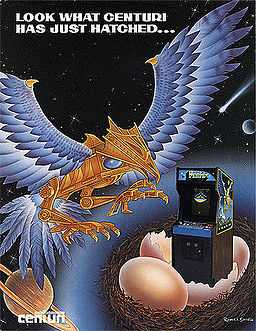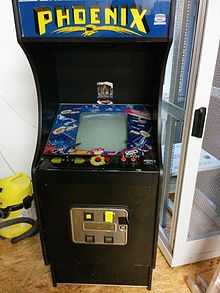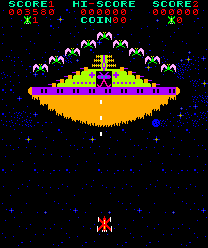Phoenix (video game)
| Phoenix | |
|---|---|
 | |
| Developer(s) | Amstar Electronics |
| Publisher(s) | Centuri, Taito (Arcade) Atari (Atari 2600) |
| Platform(s) | Arcade, Atari 2600 |
| Release date(s) | Arcade
|
| Genre(s) | Shoot 'em up |
| Mode(s) | Up to 2 players, alternating turns |
| Cabinet | Upright, cocktail |
| Display | Vertical raster, standard resolution |
Phoenix is an outer space-themed, fixed shooter video game similar to Taito's Space Invaders. It was developed by Amstar Electronics (which was located in Phoenix, Arizona) in 1980,[1] and released by Centuri in the United States and by Taito in Japan.[2][3]
The Phoenix mothership is one of the first video arcade game bosses to be presented as a separate challenge.[4] This was before the term boss was coined.
Gameplay
The player controls a spaceship that moves horizontally at the bottom of the screen, firing upward. Enemies, typically one of two types of birds, appear on the screen above the player's ship, shooting at it and periodically diving towards it in an attempt to crash into it. The ship is equipped with a shield that can be used to zap any of the alien creatures that attempt to crash into the spaceship. The player cannot move while the shield is active and must wait approximately five seconds before using it again.
The player starts with three or six lives, depending on the settings.
Each level has five separate rounds. The player must complete a round to advance to the next.
- Rounds 1 and 2 – The player must destroy a formation of alien birds. While in formation, some of the birds fly down kamikaze style, in an attempt to destroy the player's spaceship by crashing into it. Hitting a bird flying diagonally awarded a bonus score. The birds are yellow in round 1, pink in round 2. The player's spaceship is given rapid fire for round 2, where the birds fly somewhat more unpredictably. These rounds are highly reminiscent of Galaxian.
- Rounds 3 and 4 – Flying eggs float on the screen and seconds later hatch, revealing larger alien birds, resembling phoenices, which swoop down at the player's spaceship. The only way to fully destroy one of these birds is by hitting it in its belly; shooting one of its wings merely destroys that wing, and if both wings are destroyed, they will regenerate. From time to time the birds could also revert to the egg form for a brief period of time. The birds are blue in round 3, pink in round 4.
- Round 5 – The player is pitted against the mothership, which is controlled by an alien creature sitting in its center. To complete this round, the player must create a hole in the conveyor belt-type shield to get a clear shot at the alien. Hitting the alien with a single shot ends the level. The mothership fires missiles at the player, moves slowly down towards him, and has alien birds (from rounds 1 and 2) protecting the ship. Defeating all of the birds will produce a new wave.
The game continues with increasing speed and unpredictability of the bird and phoenix flights.
Music
There are two pieces of music featured in the game:
- Romance de Amor also known as Spanish Romance by an unknown composer.
- Für Elise by Beethoven.
Clones
- Griffon was released by Videotron in 1980.
- Falcon was released by BGV. in 1980.
- Vautour was released by Jeutel in 1980 in France.
- Condor was released by Sidam in 1981.
- Pheenix was released by Megadodo for the ZX Spectrum in 1983.
- Eagle Empire was released by Alligata Software for the BBC Micro in 1983.
- Various games titled Phoenix are available for many graphing calculators.
Bootlegs
- Phoenix was released by T.P.N in 1980.
- Phoenix was released by IRECSA, G.G.I Corp in 1980.
Sequels
The official sequel to Phoenix was called Pleiads (onscreen) or Pleiades (on the Centuri manufactured marquee) and was developed by Tehkan in 1981, and licensed to Centuri for US distribution. Pleiades featured more enemies attacking at once, balanced by the fact that the player could now have two shots on the screen at one time instead of one - coincidentally, something that Galaxian's sequel, Galaga, also introduced.
The Flagship level in the Midway game Gorf has been compared to the boss stage in Phoenix.
Hardware

Phoenix was available in both arcade and cocktail cabinets. A DIP switch setting allows the game to be moved between formats.
Most Phoenix games are in a standard Centuri woodgrain cabinet, but several other cabinets exist, due to this game being sold by multiple companies at the same time. These use sticker sideart (which covers the upper half of the machine), and glass marquees. The control panel is made up entirely of buttons, no joysticks are present in the arcade version, except for the Italian made model and some cocktail versions. The monitor in this machine is mounted vertically, and the monitor bezel is relatively unadorned. Phoenix uses a unique wiring harness, which isn't known to be compatible with any other games.
Circuitry in the Centuri version:
- CPU: 8085 at 5.5 MHz.
- RAM: 4 kB (8 2114 1k x 4 chips.)
- ROM: 16 kB (8 2716 2k x 8 chips.)
- Audio: Matsushita MN6221AA chip, along with discrete circuitry.
- Video: discrete circuitry, utilizing 4 more 2716 2k x 8 EPROMs, as well as 2 256 x 4 bipolar PROMs.[5]
Records
Richie Knucklez holds the official record for this game with 1,007,115 points recorded on the 9 March 2011.[6]
Ports
Atari bought the home video game console rights to Phoenix, which it released for the Atari 2600 in 1982.[3][7] The Imagic game Demon Attack closely resembled Phoenix, so Atari sued Imagic, who settled out of court. The home version of Phoenix is one of the more accurate arcade ports of the time.
Taito appears to currently hold the worldwide rights to the game - in 2005, Phoenix was released on the Xbox, PlayStation 2, PSP and the PC as part of Taito Legends in the US and Europe, and Taito Memories II Gekan in Japan.
Reception
Bill Kunkel and Arnie Katz of Electronic Games called Phoenix "perhaps the finest invasion title ever produced for the 2600!", praising its "fantastic graphics, unexcelled play-action and more".[7]
AllGame gave Phoenix five out of five stars, praising it's "Finely balanced shooting action combined with colorfully animated graphics". The review stated that it was "a true classic among shooters" and "one of the most impressive games the "slide-and-shoot" genre has to offer, bested only by Galaga in terms of sheer enjoyment and replayability."[8]
References
- ↑ p. 163, Racing the beam: the Atari Video computer system, by Nick Montfort and Ian Bogost, MIT Press, 2009, ISBN 0-262-01257-X.
- ↑ Phoenix at the Killer List of Videogames
- ↑ 3.0 3.1 Phoenix at Allgame
- ↑ 4.0 4.1 Sterbakov, Hugh. (2008-03-05) The 47 Most Diabolical Video-Game Villains of All Time. Gamepro. Retrieved on 2008-04-28.
- ↑ Phoenix service manual, Centuri, Inc., #364-62-0100 A.
- ↑ http://article.wn.com/view/2011/05/09/The_Start_Button_Knucklez_beats_Phoenix_record_West_sets_Fre/
- ↑ 7.0 7.1 Katz, Arnie; Kunkel, Bill (June 1983). "Programmable Arcade". Electronic Games. pp. 38–42. Retrieved 6 January 2015.
- ↑ Weiss, Brett Alan. "Phoenix". AllGame. Archived from the original on November 14, 2014. Retrieved December 23, 2014.
External links
| Wikimedia Commons has media related to Phoenix (video game). |
- Phoenix guide at StrategyWiki
- Phoenix at the Killer List of Videogames
- Arcade History Database entry
- Phoenix entry at the Centuri.net Arcade Database
- Twin Galaxies High Score Rankings for Phoenix
